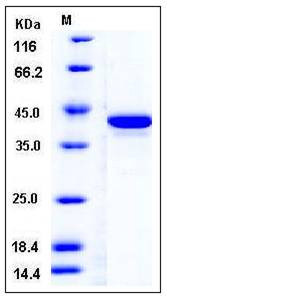Human STK10 / LOK Protein (His Tag)
LOK,PRO2729
- 100ug (NPP4292) Please inquiry
| Catalog Number | P11724-H07E |
|---|---|
| Organism Species | Human |
| Host | E. coli |
| Synonyms | LOK,PRO2729 |
| Molecular Weight | The recombinant human STK10 consisting of 315 amino acids and has a calculated molecular mass of 36 kDa. It migrates as an approximately 40 kDa band in SDS-PAGE under reducing conditions. |
| predicted N | Met |
| SDS-PAGE |  |
| Purity | > 95 % as determined by SDS-PAGE |
| Protein Construction | A DNA sequence encoding the human STK10 (NP_005981.3) (Arg 18-Glu 317) was expressed, with a polyhistide tag at the N-terminus. |
| Bio-activity | The specific activity was determined to be 1353 nmol/min/mg using synthetic AXLtide peptide (KKSRGDYMTMQIG) as substrate. |
| Research Area | Immunology |Signal Transduction |Protein Kinase |Intracellular Kinase |Other Intracellular Protein Kinases |
| Formulation | Supplied as sterile 20mM Tris, 500mM NaCl, pH 8.0 1. Normally 5 % - 8 % trehalose, mannitol and 0.01% Tween80 are added as protectants before lyophilization. Specific concentrations are included in the hardcopy of COA. |
| Background | Serine / threonine-protein kinase 10, also known as Lymphocyte-oriented kinase, STK10 and LOK, which belongs to the protein kinase superfamily, STE Ser / Thr protein kinase family and STE20 subfamily. Protein kinases constitute a large superfamily of enzymes with key regulatory functions in nearly all signal transmission processes of eukaryotic cells. The Ste20 family of serine/threonine kinases plays an important role in numerous cellular functions such as growth, apoptosis, and morphogenesis. STK10 is similar to several known polo-like kinase kinases. It can associate with and phosphorylate polo-like kinase 1, and overexpression of a kinase-dead version of the protein interferes with normal cell cycle progression. STK10 can also negatively regulate interleukin 2 expression in T-cells via the mitogen activated protein kinase kinase 1 pathway. Stk10 can associate with Plk1 in cells and furthermore can phosphorylate Plk1. It can also act on substrates such as myelin basic protein and histone 2A on serine and threonine residues. |
| Reference |
